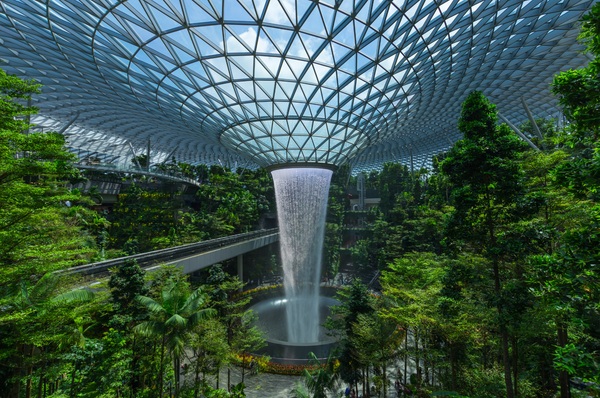Sustainable Luxury Travel: Reduce Your Carbon Footprint with Stylish Home Exchanges
Sustainable luxury travel is redefining the way we explore the world. Discover how home exchanges offer an elegant, eco-friendly alternative to traditional accommodations — without sacrificing comfort or style.

Sustainable luxury travel offers a refined way to explore the world without burdening our planet. Eco-friendly choices protect the environment and enrich the travel experience.
Home exchanges are reshaping travel by reducing reliance on energy-intensive hotels and keeping homes actively lived in. Unlike rentals, which can drive speculative buying and leave properties empty, home swapping ensures that existing homes remain in use. This approach minimizes waste, conserves resources, and offers a practical alternative for travelers looking to reduce their environmental impact.
Sustainable travel matters as global temperatures rise and environmental concerns grow. Making informed choices allows travelers to minimize their impact while exploring the world.
Informed travel can drive significant change in the travel industry. Sustainable destinations invest in renewable energy and waste reduction while preserving local heritage. This shift benefits both the environment and the local economy.
In this post, we’ll define sustainable luxury travel, compare its benefits to traditional methods, and reveal practical steps to help you travel responsibly.
What does sustainable luxury travel mean?
Sustainable luxury travel blends high-end experiences with environmentally responsible practices. It means choosing accommodations and activities that minimize energy use and waste. Travelers enjoy refined comforts while actively lowering their carbon footprint.
This approach prioritizes renewable energy, efficient resource use, and support for local communities. It shifts the focus from excess to mindful consumption and conservation, making luxury a vehicle for positive environmental impact.
What is the environmental impact of traditional luxury travel?
Traditional luxury travel offers high-end experiences but often comes with a significant environmental cost that contributes heavily to greenhouse gas emissions and waste through:
Carbon emissions from long-haul flights
Long-haul flights burn large amounts of fossil fuels, releasing significant carbon dioxide into the atmosphere. While aircraft have become more fuel-efficient, the growing demand for international travel offsets these improvements.
Some travelers must cross continents for vacations, work, or other commitments.
Beyond emissions, air travel contributes to noise pollution and airport expansion, which can disrupt local ecosystems. Advancing fuel-efficient technology and carbon offset initiatives can help reduce these effects.
Cruise ships and marine impact
Cruise ships offer luxurious experiences but are associated with considerable environmental concerns. They generate multiple waste streams, including sewage, gray water, hazardous wastes, oily bilge water, ballast water, and solid waste.
If not properly treated and disposed of, these wastes can introduce pathogens, nutrients, and toxic substances into marine environments, threatening human health and aquatic life.
Air pollution is another significant issue with cruise ships. Most run on heavy fuel oil, or "bunker fuel," which has a high sulfur content and produces sulfur dioxide emissions worse than those of equivalent road traffic.
Efforts to regulate cruise ship pollution have included banning them from sensitive areas and implementing stricter environmental standards. However, the industry's carbon emissions remain substantial, and waste management practices often fail to minimize ecological harm.
Energy consumption in high-end hotels and resorts
Luxury hotels and resorts require substantial energy to maintain premium services and amenities. Many still rely on outdated, inefficient systems that drive excessive energy consumption. This high energy demand significantly increases their carbon footprint.
Excessive air conditioning, heating, and lighting use contribute to elevated energy usage. Reliance on non-renewable energy sources exacerbates environmental impacts.
Upgrading to energy-efficient systems and incorporating renewable energy sources are essential steps toward sustainability. Innovative designs and technologies offer promising solutions for reducing energy consumption.
Implementing innovative energy management systems and sustainable architectural practices can significantly lower the environmental footprint of luxury accommodations. Embracing these changes is crucial for the future of eco-friendly luxury travel.
Check out this luxury hotel alternative
How to promote sustainable luxury travel
Promoting sustainable luxury travel means embracing strategies that reduce waste, lower emissions, and support local economies. It requires rethinking each step of the journey.
Here are eight actionable, original methods to travel luxuriously and responsibly:
Choose sustainable destinations
Choose destinations that prioritize environmental stewardship and invest in renewable energy and conservation. Opt for places with clear sustainability policies, eco-friendly infrastructure, and responsible tourism initiatives that minimize waste and resource consumption.
Exploring locations closer to home further reduces transportation emissions, reducing the environmental impact of long-haul travel. Many sustainable destinations also implement efficient public services and waste management, helping visitors travel responsibly without adding to pollution.
Utilize home exchange programs
Home exchanges offer a smart alternative to traditional, energy-intensive accommodations. You avoid the high energy demands of hotels and gain access to a more sustainable travel option by swapping homes.
Travel, especially long-haul flights, contributes to carbon emissions. However, once at the destination, home swapping minimizes environmental impact by reducing reliance on resource-intensive hotels, which require large-scale construction, high energy consumption, and frequent linen and amenity waste.
For those seeking a high-end experience, HomeExchange Collection provides access to an exclusive network of luxury homes. These upscale properties often integrate eco-conscious design, renewable energy sources, and waste-reduction strategies.
Beyond exceptional accommodations, home exchanges foster meaningful connections with hosts who actively promote green living. Many homeowners incorporate sustainability into their daily lives and share valuable insights on reducing waste, conserving energy, and supporting local eco-friendly initiatives.
See also: Is House Swapping Still a Thing?
Adopt low-emission transportation
Opt for public transit, cycling, or electric vehicles when moving around your destination. These choices significantly lower fossil fuel consumption compared to rental cars or flights. Embracing low-emission transportation is a direct way to cut your carbon output.
Research local transit options in advance to plan efficient routes. Many cities offer robust, eco-friendly networks that reduce congestion and air pollution. Prioritizing these options supports cleaner urban environments.
You can filter on HomeExchange for vacation homes with public transport access, and the search results will only show homes accessible via public transport, as specified by their owners.
Support local, sustainable businesses
Seek restaurants, shops, and services prioritizing renewable energy and ethical practices. Local, sustainable businesses often use energy-efficient processes to reduce waste. Supporting these enterprises helps reinforce eco-friendly standards in tourism.
They frequently source ingredients and materials locally, reducing transportation emissions. This practice benefits the environment and the local economy. Your spending directly contributes to a greener, more resilient community.
Engaging with these businesses also provides authentic insights into regional culture. Their commitment to sustainability is often reflected in quality and personalized service.

Practice energy conservation at accommodations
Look for places with signs of renewable energy use, such as solar panels and smart thermostats. Energy conservation at your accommodation can significantly lower your environmental impact.
When not in use, simple actions like turning off lights can lead to significant savings. Many eco-friendly properties offer guidelines to help guests minimize resource use, supporting a broader move toward sustainable hospitality.
You contribute to the demand for greener travel options by staying at energy-conscious accommodations. This encourages further innovation in sustainable technologies, helping to push the travel industry toward a cleaner future.
View our homes with eco-friendly ammenties
Encourage slow travel experiences
Extending stays in one location lowers the need for frequent transportation, cutting carbon emissions from flights and vehicles. This approach allows for a richer cultural experience while supporting local businesses and sustainable accommodations.
Immersing in a single destination fosters a deeper understanding of traditions, ecosystems, and conservation efforts. Luxury travelers benefit from exclusive, eco-conscious experiences such as locally guided nature retreats and regenerative tourism initiatives.
Choosing slow travel enhances relaxation, reduces travel fatigue, and aligns with responsible tourism principles.
Educate yourself and others on sustainable practices
Staying informed about environmental issues and renewable technologies is key to responsible travel. Regularly read reliable sources and attend workshops on sustainability. This knowledge empowers you to make smarter travel choices.
Share insights with friends and fellow travelers to spread eco-friendly practices. Encouraging discussions and community learning can foster broader change in the tourism industry. Knowledge becomes the foundation for a more sustainable travel culture.
You can advocate for policies that protect the environment by continuously educating yourself. Your informed decisions help drive demand for green travel initiatives. Every conversation and shared tip adds to the momentum for responsible luxury travel.
Practical steps to engage in sustainable luxury home exchanges
Home exchanges offer a direct, eco-friendly alternative to conventional lodging. They eliminate the need for energy-intensive hotels and reduce travel emissions.
Let’s explore seven practical steps to ensure your home swap is sustainable and seamless.

Step 1: Research reliable home exchange platforms
Identify trusted platforms with detailed, eco-friendly property profiles and transparent user reviews. Focus on sites that emphasize sustainability through renewable energy use and energy-efficient lighting.
This research ensures you connect with listings that align with your commitment to reducing greenhouse gas emissions. A well-vetted platform also provides tools to filter properties by their environmental credentials.
At HomeExchange, a certified B Corp, we uphold high environmental and social standards while offering a secure and flexible exchange system. Our platform allows members to filter listings based on eco-friendly features, making sustainable travel easier than ever.
Comparing homes based on energy-efficient design, waste reduction initiatives, and other sustainability efforts helps ensure a responsible and seamless exchange experience.
Step 2: Assess sustainability credentials
Review each property’s eco features, such as solar panels, energy-efficient appliances, and water conservation systems. Check for certifications or third-party reviews that confirm the accommodation’s green practices.
You should also carefully evaluate details like renewable energy usage and waste management practices. A property with clear, verifiable green credentials often reflects the host’s commitment to sustainability.
This assessment minimizes hidden environmental impacts and reinforces your eco-friendly travel goals.
Step 3: Plan eco-friendly travel logistics
Coordinate your journey to avoid long-haul flights and minimize reliance on fuel-intensive transportation where possible. To reach your destination, prioritize local public transportation, cycling, or electric vehicles.
Integrate sustainable travel tips into your itinerary, such as using reusable water bottles and reducing single-use plastics. Researching transit options in advance can save time and energy.
Smart logistics support renewable energy practices and promote conservation efforts in tourist hotspots.
Step 4: Communicate clearly with exchange partners
Open a dialogue with your exchange partner about your sustainability priorities. Discuss energy use, waste reduction, and local eco-initiatives before confirming the exchange.
Clear communication builds trust and ensures both parties share a commitment to lowering their environmental impact. Messaging back and forth before finalizing an exchange provides the perfect opportunity to discuss eco-friendly practices.
HomeExchange Collection makes it easy for members to communicate expectations and ensure both parties prioritize eco-friendly practices. You can address responsible energy use, waste reduction, and other sustainable efforts in advance, creating a more mindful and seamless exchange.
When listing your home, the platform also lets you showcase eco-friendly features, helping you connect with travelers who value sustainable living.
Step 5: Prepare your home for a green exchange
Before hosting guests, ensure your home reflects sustainable practices. Update energy infrastructure by installing energy-efficient lighting and optimizing heating and cooling systems.
Simple measures like recycling and reducing organic waste can make your property more eco-friendly and appealing to like-minded travelers.
Provide guidelines for energy use, water conservation, and waste management that your guests can easily follow. Also, highlight any renewable energy systems you have in place, such as solar panels or efficient water heating.
Step 6: Share and learn from community experiences
Engage with online communities or forums dedicated to sustainable travel and home exchanges. Sharing tips and learning from others can provide valuable insights into reducing environmental impact. These networks also offer firsthand reviews on how to support local cultures and conservation efforts effectively.
Participate in community discussions about renewable energy use, sustainable accommodations, and eco-travel tips. This exchange of ideas enhances your own practices and supports broader sustainability initiatives.
Learning from community experiences helps refine your travel strategies and benefits local economies.
Read member stories and community tips
Step 7: Follow up with post-travel feedback
After your exchange, provide honest feedback regarding the property’s eco practices and your overall experience. Sharing insights on energy-efficient systems and sustainability measures helps future travelers make informed choices.
It also encourages hosts to improve their renewable energy and conservation efforts continuously. Reflect on your carbon savings compared to traditional travel methods and discuss areas for improvement.
Your feedback can support the growth of sustainable travel initiatives and bolster local community efforts.
You may also like: Is Home Swapping a Good Idea?
Takeaway: Redefine luxury travel for a greener future
Home exchanges are a practical method to travel while conserving energy and resources. This model encourages cultural immersion and economic growth in local markets, ensuring that your travel supports sustainable tourism.
Investing in sustainable travel is an investment in our planet’s future. It involves adopting renewable energy, reducing waste, and engaging with community–based tourism initiatives that emphasize local artisans and traditional culture.
Ready to make a difference? Embrace sustainable luxury home exchanges and start your journey toward a greener, more responsible travel experience. Visit HomeExchange Collection for luxury home exchanges that embrace both elegance and sustainability.
FAQs
Here are the answers to some common questions about sustainable luxury travel and eco-friendly home exchanges:
What are the 5 C's of luxury travel?
The five C’s of luxury travel are Culture, Cuisine, Community, Content, and Customization. These elements define high-end travel by focusing on unique experiences and personal preferences.
- Culture: Engaging with local traditions, history, and heritage.
- Cuisine: Enjoying high-quality, authentic, and gourmet food experiences.
- Community: Connecting with locals and supporting responsible tourism.
- Content: Seeking enriching experiences that provide personal growth.
- Customization: Tailoring trips to individual tastes for exclusivity.
What is a carbon footprint?
A carbon footprint measures the total greenhouse gas emissions caused by an individual or activity, including energy use and fossil fuels. It quantifies the environmental impact, especially the energy consumption from air travel and accommodation.
Do people still do home swaps?
Home swaps remain popular among eco-conscious travelers seeking to lower their carbon footprint. Local swaps offer a practical alternative to traditional hotel stays and reduce emissions from long-haul flights.
Home exchange programs support local communities by promoting authentic cultural immersion and sustainable travel.
What is the best home swap website?
The best home swap websites prioritize transparency, verified eco credentials, and user reviews that highlight energy-efficient practices. HomeExchange Collection offers luxury homeowners a seamless exchange of exquisite properties while promoting responsible travel.
With personalized support and comprehensive guarantees, members can confidently enjoy high-end stays, knowing they are part of a community that values comfort and sustainability.
How do I become an eco-friendly traveler?
Start by researching destinations focusing on renewable energy, conservation, and sustainable tourism initiatives. Then, embrace practical tips such as using a reusable water bottle, reducing single-use plastics, and choosing low-emission transportation.
Engaging with local artisans and community events further deepens your commitment to reducing your environmental footprint.
Which form of travel is the greenest?
Travel methods that avoid long-haul flights and minimize fossil fuel usage, like train travel or home exchanges, tend to be the greenest. These alternatives help reduce carbon dioxide emissions and support clean energy initiatives.
Opting for low-emission transportation and energy-efficient accommodations significantly lowers your overall environmental impact.
Why should you consider a home exchange?
Home exchanges offer an authentic way to experience local culture while drastically reducing energy-intensive hotel stays. They minimize carbon emissions by reducing air travel and supporting local economies. This eco-friendly approach promotes conservation efforts and fosters deeper connections with local communities.
What is the golden rule of home exchange?
The golden rule is to treat your exchange partner’s home with the utmost respect, just as you would your own. This ensures trust and a mutually beneficial experience while minimizing your environmental impact.
Who benefits the most from a house swap?
House swaps benefit both travelers and host communities. Eco-conscious individuals enjoy lower emissions and immersive experiences, while local communities gain economic support and cultural exchange. This win-win model enhances sustainable travel by reducing reliance on traditional, high-emission accommodations.




